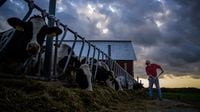American cattle ranchers are facing a storm of challenges in late 2025, and many say the latest blow has come not from drought, tariffs, or market consolidation—but from President Donald Trump himself. In a move that has sparked outrage across the agricultural heartland and drawn criticism from both political allies and opponents, Trump’s administration has announced plans to quadruple U.S. imports of beef from Argentina, a decision that many see as a sharp break from his long-touted "America First" trade agenda.
For much of his political career, Trump has promised to prioritize American producers, railing against the import of cheaper foreign goods and pledging to protect domestic jobs. Yet, according to USA TODAY, his October 2025 proposal to boost Argentine beef imports has left ranchers and their advocates feeling betrayed. The National Cattlemen’s Beef Association CEO Colin Woodall minced no words, stating, “This plan only creates chaos at a critical time of the year for American cattle producers, while doing nothing to lower grocery store prices. … Argentina also has a history of foot-and-mouth disease, which, if brought to the United States, could decimate our domestic livestock production.”
It’s not just industry leaders sounding the alarm. Kyle Hemmert, a 61-year-old Kansas cattle rancher, told The New York Times, “It’s really just a kick in the nuts. Come on President Trump, this is ‘America First’ policy? No.” The frustration is echoed online, with Wyoming’s Meriwether Farms calling Trump’s plan an “absolute betrayal to the American cattle rancher” in a viral post on X (formerly Twitter).
Why does this matter so much? The price of ground beef hit a record $6.63 per pound in August 2025, according to the U.S. Bureau of Labor Statistics, and beef prices overall are up 15% in the last year. These increases are a major driver of the 3.1% rise in food prices, squeezing both consumers and producers. The national cattle herd is at a 75-year low, battered by years of drought and inflated feeding costs. Independent ranchers, already struggling with an industry dominated by just four meat processing companies controlling over 80% of the market, now face the prospect of even more competition from abroad.
Trump’s reasoning, as he explained aboard Air Force One, is that Argentina is “fighting for their life” amid a severe economic crisis, and that supporting President Javier Milei, a close ideological ally, is necessary. “They have no money, they have no anything. They’re fighting so hard to survive. If I can help them survive in a free world — I happen to like the president of Argentina, I think he’s trying to do the best he can. But don’t make it sound like they’re doing great,” Trump told reporters, as reported by The Hill.
But critics from across the political spectrum argue that the move is less about lowering prices for Americans and more about bailing out Milei’s government. “Look, I’m all for lowering prices, but this is not actually about lowering prices. This is about taking care of his buddy,” said Senator Ruben Gallego of Arizona. Even staunch Trump allies like Representative Marjorie Taylor Greene have broken ranks, calling the plan “a punch in the gut to all of our American cattle ranchers, and they are furious and rightfully so.”
The backlash has not been limited to beef producers. American soybean farmers are also feeling the pain. As reported by USA TODAY and Oil City News, Trump’s administration recently provided a $20 billion bailout to Argentina, enabling Argentine farmers to sell soybeans to China—a market that had traditionally relied on U.S. exports. “The frustration is overwhelming,” American Soybean Association President Caleb Ragland said in a statement. “U.S. soybean prices are falling, harvest is underway, and farmers read headlines not about securing a trade agreement with China, but that the U.S. government is extending $20 billion in economic support to Argentina while that country drops its soybean export taxes to sell 20 shiploads of Argentine soybeans to China in just two days.”
Meanwhile, the pain for families and workers is growing. Recipients of the Supplemental Nutrition Assistance Program (SNAP) were informed they may not be paid out come November 1, 2025, affecting close to 30,000 individuals in Wyoming alone, Oil City News reported. Grocery prices are climbing, and the ongoing federal government shutdown has left hundreds of thousands of federal workers without paychecks. The administration’s spending—such as a $300 million White House renovation and Trump’s demand for $230 million in restitution from the Department of Justice for legal fees—has only added fuel to the fire, raising questions about priorities and who truly benefits from current policies.
Senator Chuck Grassley of Iowa, a state hit hard by the trade war’s fallout, was blunt: “The president would be better off if he’d keep his mouth shut on that issue and not tweet about it. You aren’t going to win it. He should concentrate on what he’s doing to help the beef producers,” he told The Des Moines Register.
There’s also a sense of inconsistency in Trump’s approach. Senator Rand Paul noted, “The plan seems to kind of go against the protectionism that he’s promoting in every other industry, and so I think there are some inconsistencies in that. I personally am for competition and for international trade.”
For ranchers, the sense of betrayal runs deep. The U.S. Department of Agriculture highlighted the importance of cattle production, noting it accounted for about 22% of the $515 billion in total cash receipts for agricultural commodities in 2024. Yet, as Wyoming’s Meriwether Farms put it, “On top of all this ‒ there is only chaos coming from the Department of Agriculture. There is no true guidance, mixed messaging, and a copious amount of photo ops.”
Industry groups are urging the Trump administration to focus on long-term solutions: restoring mandatory country-of-origin labeling, expanding regional processing plants, supporting herd restocking, and investing in biosecurity measures. “If President Trump is truly an ally of America’s cattle producers, we call on him to abandon this effort to manipulate markets and focus instead on the promised New World Screwworm facilities in Texas; making additional investments that protect the domestic cattle herd from foreign animal diseases … and addressing regulatory burdens,” said Colin Woodall of the National Cattlemen’s Beef Association.
Amid the uncertainty, local community organizations like the Food Bank of the Rockies and the Food for Thought Project are stepping up to support those left behind by federal policies. As one Oil City News letter put it, “We cannot rely on the federal government right now as it withholds funding and abandons its vulnerable citizenry.”
With trust eroding and livelihoods on the line, the future for America’s farmers and ranchers looks more uncertain than ever. As the debate rages, one thing is clear: the decisions made in Washington are reverberating across kitchen tables and pastures from Wyoming to Kansas, reshaping the very fabric of rural America.


